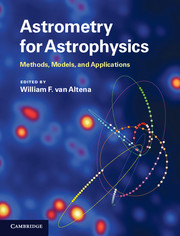Book contents
- Frontmatter
- Contents
- List of contributors
- List of acronyms
- Preface
- Part I Astrometry in the twenty-first century
- Part II Foundations of astrometry and celestial mechanics
- Part III Observing through the atmosphere
- Part IV From detected photons to the celestial sphere
- Part V Applications of astrometry to topics in astrophysics
- 22 Galactic structure astrometry
- 23 Binary and multiple stars
- 24 Binaries: HST, Hipparcos, and Gaia
- 25 Star clusters
- 26 Solar System astrometry
- 27 Extrasolar planets
- 28 Astrometricmeasurement and cosmology
- Index
- References
26 - Solar System astrometry
from Part V - Applications of astrometry to topics in astrophysics
Published online by Cambridge University Press: 05 December 2012
- Frontmatter
- Contents
- List of contributors
- List of acronyms
- Preface
- Part I Astrometry in the twenty-first century
- Part II Foundations of astrometry and celestial mechanics
- Part III Observing through the atmosphere
- Part IV From detected photons to the celestial sphere
- Part V Applications of astrometry to topics in astrophysics
- 22 Galactic structure astrometry
- 23 Binary and multiple stars
- 24 Binaries: HST, Hipparcos, and Gaia
- 25 Star clusters
- 26 Solar System astrometry
- 27 Extrasolar planets
- 28 Astrometricmeasurement and cosmology
- Index
- References
Summary
Introduction
This chapter focuses on the peculiarities of astrometry applied to Solar System objects. This is a whole subject by itself and within the scope of this book we will restrict ourselves to an overview, emphasizing the features that make Solar System observations definitely distinct from stellar astrometry.
A beginner would naively think that Solar System astrometry deals primarily, if not only, with the major planets. Actually, the field is much broader and the planets are only a very small subset of the whole subject.
The list of potential sources is conveniently broken down into large categories as follows:
• The major planets from Mercury to Neptune. They are much too big, let alone too bright, to be observed by conventional astrometric techniques (meaning to determine their positions) in a direct way, although this remark does not fully apply to transit instruments. Their true positions are eventually obtained from the positions of their faint satellites against the background stars combined with the theory of their motion. In this chapter we omit physical observations of the planets necessary to determine their rotation and establish a local reference frame on their surfaces.
• The planetary satellites, Table 26.1, comprising three subcategories:
(i) The small inner satellites, orbiting very close to the planetary surface and, for the giant planets, connected to their ring system.
(ii) The classical satellites, usually the largest, orbiting at a few planetary radii, with low inclination to the planet's equatorial plane and nearly circular orbits.
(iii) The faint outer satellites, orbiting on eccentric irregular orbits, prograde or retrograde.
[…]
- Type
- Chapter
- Information
- Astrometry for AstrophysicsMethods, Models, and Applications, pp. 368 - 378Publisher: Cambridge University PressPrint publication year: 2012



